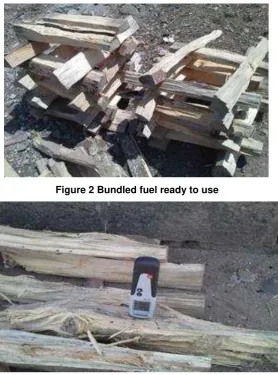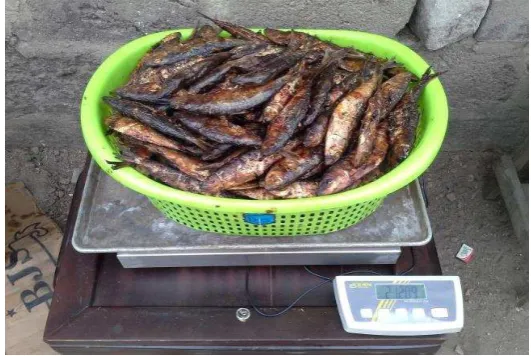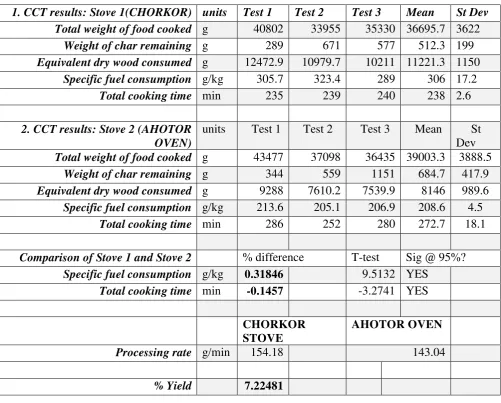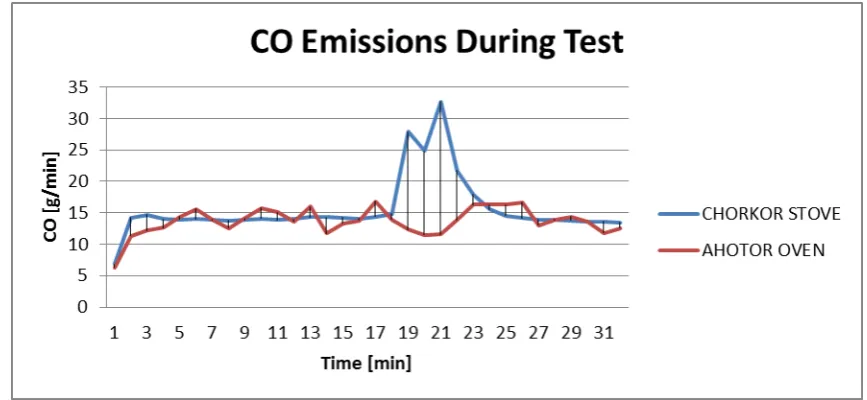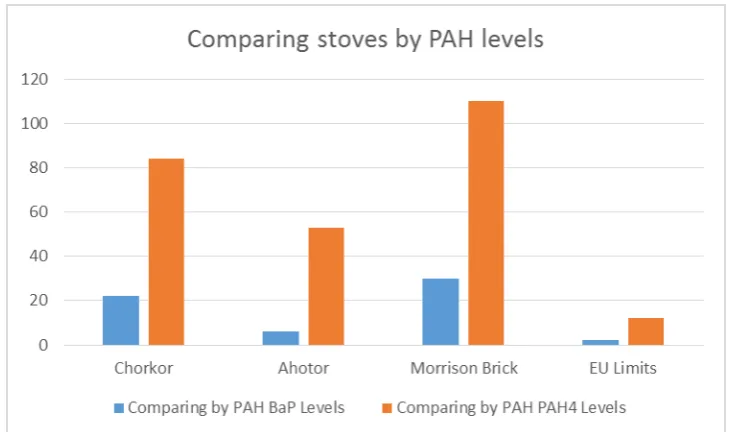SUSTAINABLE FISHERIES
MANAGEMENT PROJECT (SFMP)
Testing Of Low PAH Improved Fish
Smoking Stove (Ahotor Oven)
This publication is available electronically on the Coastal Resources Center’s website at http://www.crc.uri.edu/projects_page/ghanasfmp/
For more information on the Ghana Sustainable Fisheries Management Project, contact:
USAID/Ghana Sustainable Fisheries Management Project Coastal Resources Center
Graduate School of Oceanography University of Rhode Island
220 South Ferry Rd.
Narragansett, RI 02882 USA
Tel: 401-874-6224 Fax: 401-874-6920 Email: info@crc.uri.edu
Citation: Institute for Industrial Research- CSIR, Ghana Standard Authority, Kwarteng E. (2016). Testing of Low PAH Improve Fish Smoking Stove (Ahotor oven). The USAID/Ghana Sustainable Fisheries Management Project (SFMP), Narragansett, RI: Coastal Resources Center, Graduate School of Oceanography, University of Rhode Island. GH2014_ACT067_SNV. 19p.
Authority/Disclaimer:
Prepared for USAID/Ghana under Cooperative Agreement (AID-641-A-15-00001), awarded on October 22, 2014 to the University of Rhode Island, and entitled the USAID/Ghana Sustainable Fisheries Management Project (SFMP).
This document is made possible by the support of the American People through the United States Agency for International Development (USAID). The views expressed and opinions contained in this report are those of the SFMP team and are not intended as statements of policy of either USAID or the cooperating organizations. As such, the contents of this report are the sole responsibility of the SFMP team and do not necessarily reflect the views of USAID or the United States Government.
Detailed Partner Contact Information:
USAID/Ghana Sustainable Fisheries Management Project (SFMP) 10 Obodai St., Mempeasem, East Legon, Accra, Ghana
Telephone: +233 0302 542497 Fax: +233 0302 542498
Maurice Knight Chief of Party maurice@crc.uri.edu
Kofi Agbogah Senior Fisheries Advisor kagbogah@henmpoano.org Nii Odenkey Abbey Communications Officer nii.sfmp@crcuri.org
Bakari Nyari Monitoring and Evaluation Specialist hardinyari.sfmp@crcuri.org Brian Crawford Project Manager, CRC brian@crc.uri.edu
Justice Odoi USAID Administrative Officer Representative Jodoi@usaid.gov
Kofi.Agbogah
SNV Netherlands Development Organisation #161, 10 Maseru Road,
E. Legon, Accra, Ghana 233 30 701 2440
Donkris Mevuta Kyei Yamoah info@fonghana.org Friends of the Nation Parks and Gardens Adiembra-Sekondi, Ghana 233 312 046 180
Peter Owusu Donkor Spatial Solutions
powusu-donkor@spatialdimension.net #3 Third Nautical Close,
Nungua, Accra, Ghana
Darkuman Junction, Kaneshie Odokor Highway
Accra, Ghana 233 302 315894
Gifty Asmah
giftyasmah@Daasgift.org Daasgift Quality Foundation
Headmaster residence, Sekondi College Sekondi, Western Region, Ghana 233 243 326 178
For additional information on partner activities:
CRC/URI: http://www.crc.uri.edu CEWEFIA: http://cewefia.weebly.com/
DAA: http://womenthrive.org/development-action-association-daa Daasgift:
https://www.facebook.com/pages/Daasgift-Quality-Foundation-FNGO/135372649846101 Friends of the Nation: http://www.fonghana.org Hen Mpoano: http://www.henmpoano.org
ACRONYMS
CCM Centre for Coastal Management
CEWEFIA Central and Western Region Fishmongers Improvement Association COMFISH Collaborative Management for a Sustainable Fisheries Future CoP Chief of Party
CPUE Catch Per Unit Effort
CR Central Region
CRC Coastal Resources Center at the Graduate School of Oceanography, University of Rhode Island
CRCC Central Regional Coordinating Council CSLP Coastal Sustainable Landscapes Project CSO Civil Society Organization
DA District Authorities
DAA Development Action Association DAASGIFT Daasgift Quality Foundation
DFAS Department of Fisheries and Aquatic Sciences ERF Environmental Review Form
ETP Endangered, Threatened and Protected
FAO Food and Agricultural Organization of the United Nations FC Fisheries Commission
FoN Friends of Nation FtF Feed the Future GoG Government of Ghana GSA Ghana Standards Authority
GSO Graduate School of Oceanography, University of Rhode Island
HM Hen Mpoano
LOE Level of Effort LoP Life of Project
MCS Monitoring, Control and Surveillance NGO Non-Governmental Organization
SFMP Sustainable Fisheries Management Program SMEs Small and Medium Enterprises
SNV Netherlands Development Organization SS Spatial Solutions
SSG SSG Advisors
UCC University of Cape Coast URI University of Rhode Island
USAID United States Agency for International Development USG United States Government
WASH Water, Sanitation and Hygiene
TABLE OF CONTENTS
CONTENTS
ACRONYMS ... iii
TABLE OF CONTENTS ... iv
LIST OF FIGURES ... v
LIST OF TABLES ... v
EXECUTIVE Summary... 1
INTRODUCTION ... 2
About CSIR ... 2
The Institute of Industrial Research (IIR) ... 2
Objectives of Research ... 3
EXPERIMENTAL Methods and Procedures ... 3
Brief Description of Fish Smoking Ovens ... 3
Ahotor Oven... 3
Chorkor Stove ... 3
Materials and Methods ... 4
Fuel Used ... 4
Moisture Content ... 5
Atmospheric Conditions ... 5
Experimental Procedures ... 5
Results AND Discussion... 6
Total Weight of Food Cooked ... 7
Weight of Char Remaining ... 8
Equivalent Dry Wood Consumed ... 8
Specific Fuel Consumption ... 8
Total Cooked Time ... 9
Emissions ... 9
PAH ANALYSIS OF THE AHOTOR, MORRISON & CHORKOR OVENS ... 11
CONCLUSION ... 12
LIST OF FIGURES
Figure 1 Photographs of Ahotor Oven and Traditional Chorkor Stove ... 4
Figure 2 Bundled fuel ready to use ... 4
Figure 3 Measurement of wood’s moisture content ... 4
Figure 4 Sample of weighing (a) fuelwood and (b) fish before testing. ... 5
Figure 5 Fish smoking on the (a) Ahotor Oven and (b) Chorkor stove respectively using IAP meter. ... 6
Figure 6 Weighing of smoked fish ... 6
Figure 7 Samples of CO measured using the IAP for the Chorkor Stove against Ahotor Oven ... 10
Figure 8 Samples of PM2.5 measured using the IAP for the Chorkor Stove against Ahotor Oven ... 10
Figure 9 Comparing stove by PAH levels of their smoked fish ... 12
LIST OF TABLES
Table 1 Controlled Cooking Test statistical results (t-test) for the cookstoves ... 7Table 2 Significant difference for total weight of food cooked between the means of the stoves... 7
Table 3 Significant difference for weight of char remaining between the means of the stoves 8 Table 4 Significant difference for equivalent dry wood consumed between the means of the stoves... 8
Table 5 Significant percentage for specific fuel consumption difference between the means of the stoves ... 8
Table 6 Significant percentage for specific fuel consumption difference between the means of the stoves ... 9
Table 7 Significant percentage difference for processing rate between the means of the stoves ... 9
Table 8 Significant percentage difference for CO emission between the means of the oven ... 9
EXECUTIVE SUMMARY
This report presents the findings from a Controlled Cooking Test (CCT) on an improved fish smoking stove called the AHOTOR OVEN design by the combine effort of SNV, FRI, FC and NAFPTA under the USAID funded Sustainable Fisheries Management Project. The Project aims at ending overfishing of key stocks important to local food security through a multi-pronged approach:
Improved legal enabling conditions for co-management, use rights and effort-reduction strategies
Strengthened information systems and science informed decision-making
Increased constituencies that provide the political and public support needed to rebuild fish stocks
Implementation of applied management initiatives for several targeted fisheries ecosystems
The performance test was carried out in Wenniba fishing community. This is part of the SFMP post-harvest activities strategies; to promote for the adoption of fish smoking
technology that produces fish with less PAH and also uses less fuelwood in order to enhance environmental sustainability and livelihoods. In addition, to ensue technology transfer, the event serves as an opportunity for testing and comparing stove performance (energy and production efficiencies).
In this event, SFMP/SNV Ghana therefore consulted the Regional Testing and Knowledge Centre at CSIR - Institute of Industrial Research, to conduct a comparative test to assess the performances and efficiencies of the AHOTOR OVEN technology in comparison with the Chorkor oven
The testing approach adopted was the Controlled Cooking Test (CCT) using six (6) wooden trays/shelves under the same conditions and procedures and the results were compared for fuel efficiencies and emissions. The raw data obtained from the measurements and tests were recorded for off-line analyses using the CCT 2.0 version (Rob Bailis, 2004).
From the statistical analysis (t-test) there was a significant difference of 31.8% between the Traditional Chorkor oven and Ahotor Oven @ 95% for specific fuel consumption (i.e. percentage difference in fuel savings of 31.8%) by using the Ahotor Oven. There was no significant difference for the total cooking time and processing rate (i.e percentage difference in time savings and processing rate were of 14.57% and 7.22% respectively by using the Chorkor stove). It was determined that the average CO and PM2.5 emissions for Ahotor Oven were 12.35% and 12.79% respectively and there were no significant differences in the means during the emissions test.
Average heat losses from the combustion chambers through the walls to the surroundings were recorded to be 48o C and 42.7o C for the Traditional Chorkor stove and Ahotor Oven respectively. The Ahotor Oven proved safer and efficient to be employed when compared to the Traditional Chorkor stove. It was therefore recommended that the Ahotor Oven could be promoted for the Fish processing communities.
INTRODUCTION
The United States Agency for International Development (USAID) has committed funds to the implementation of the Sustainable Fisheries Management Project (SFMP) in Ghana for five years.
The objective is to rebuild marine fisheries stocks and catches through adoption of responsible fishing practices. The project will contribute to the Government of Ghana’s fisheries development objectives and USAID’s Feed the Future Initiative.
The project is being implemented by the Coastal Resource Center (CRC) of the University of Rhode Islands (URI) through a consortium of international and local partners, including SNV Netherlands Development Organization.
SNV under the Sustainable Fisheries Management Project consulted the Regional Testing and Knowledge Centre at CSIR - Institute of Industrial Research, to conduct a comparative test to assess the performances and efficiencies of the AHOTOR OVEN technology in comparison with the Chorkor oven
About CSIR
The Council for Scientific and Industrial Research (CSIR) is a semi-autonomous organisation with the mandate to pursue the implementation of government policies on scientific research and development, encourage coordination of scientific research for the management,
utilization and conservation of the natural resources of Ghana; and to advise Government on scientific and technological advances likely to be of importance to national development. The CSIR now operates under the mandate of CSIR Act 521 of 1996, which among other things, empowers it to commercialize its research activities. The mission of CSIR is to become the force of accelerated social and economic development of Ghana through examining, exploring and creating science and technology catalysts for public and private wealth creation. The CSIR oversees 13 research institutes of which Institute of Industrial Research (IIR) is one.
The Institute of Industrial Research (IIR)
The Institute of Industrial Research is one of the leading research institutes of CSIR; among its duties, is to assist in poverty reduction through the creation of opportunities for generating and increasing incomes within the Small and Medium-scale Enterprises (SMEs); contribute towards food security, and apply cost-effective industrial technologies that are both
environmentally friendly and commercially viable. The Institute is one of the Regional Testing and Knowledge Centres supported by the United Nations Foundation through the Global Alliance for Clean Cookstoves.
The Institute of Industrial Research projects include the following:
Mitigation of the global warming problem (CO2), reduction of pollutant emission;
Higher efficiency of Ghana’s energy utilization;
Strengthening the competitive position of IIR through innovation of process technologies;
Increase knowledge in the production and application of energy such as wind, hydro, solar, fuel cells, biofuels, cookstove and fuel testing;
The CSIR-IIR research, develop and promote technologies which include renewable energy, industrial processes, new materials development, improved sanitation, locally equipment fabrication, repair/maintenance and calibration, and information technology.
Objectives of Research
The objective of this assignment is to;
• Conduct performance and efficiency test of the Ahotor Oven and the Chorkor stove.
• Conduct a comparative test between the Ahotor Oven and the Chorkor stove using Controlled Cooking Test (CCT) protocol.
EXPERIMENTAL METHODS AND PROCEDURES
Brief Description of Fish Smoking Ovens
Ahotor Oven
The Ahotor oven is built mainly with 5” sandcrete blocks and Portland cement. It has two combustion chambers which are partitioned and built with burnt bricks. The combustion chamber enhances efficient combustion of wood releasing less smoke. This makes using the stove very friendly. Inside the combustion chamber is a grate that allows for more oxygen for efficient burning of wood.
Series of wooden trays are stalked on the top of the combustion chamber which has an opening on top. The edges of the trays fitting very well preventing smoke leakages from the sides.
The stove also has a fat collecting system that prevents fats, water, blood from the fish dropping into fire to burn and increase PAH levels. These fat and blood are channel out and collected from outside.
The AHOTOR oven can hold fish capacity of over twenty (20) trays at a time with an incorporated truncated pyramid shape chimney to the design.
Chorkor Stove
The stove is built mainly with clay mixed with small quantity of sand at the 4:1 proportion has been adopted. This means that for every four (4) proportion of clay used in volume, a one (1) volume proportion each of sand was added. The trays are loaded on top of the combustion chamber but no interlocking device. The handles at the ends are chamfered for easy gripping of hands when carrying. The Chorkor stove is design to hold a capacity of eight (8) trays which dimensions are outside (1060 x 820 x 60 mm) and inside of 1035 x 795 x 60 mm (L x B x H) given a wire mesh surface area of 0.823 m2 without a chimney. The overall
Materials and Methods
Fuel Used
Sample of Yaya fuelwoods were obtained from bundled batches as shown in Figure 2. It was determined to have qualities of an average hardwood with a calorific value of 19734 kJ/kg. The average dimension of the fuel was measured to be of length 57.9±2.5 cm and a width of 10.4±1.3 cm
Figure 2 Bundled fuel ready to use
Moisture Content
The moisture content of the fuel was determined by using moisture meter Voltcraft FM-300 (Conrad Electronics SE, Hirschau) which measurement was in dry basics. Five (5) samples of the fuel were collected at random and measurements were taken at four (4) locations in each fuel selected for a bundle of wood as shown in Figure 3. Average values were therefore determined and converted in wet basics. The moisture content was determined to be 61.1%. Atmospheric Conditions
The stoves were tested in the field which is well ventilated with a light breeze. The atmospheric conditions (temperature and humidity) were determined with a temperature, humidity and clock meter THC-2 and the average temperature of 30.5oC and relative humidity of 61.8% were recorded.
Experimental Procedures
For Controlled Cooking Test (CCT), the same weight of fuelwood and fish were weighed for each stove accordingly. The cook was to prepare a good quality smoked fish product where time to cook and amount of fuel used were measured after completion of operation. An electronic weighing scale (KERN DE 60 K1 DL) of maximum weight of 60 kg and resolution of 0.5 g was used to weigh the fuelwood and fish for both before the process as presented in Figure 4a and 4b respectively. Figure 5 depicts smoking of fish using both Ahotor Oven and Chorkor stove respectively during the CCT with the Indoor Air Pollution (IAP) meter attached to the cook, in order to measure and record the possible inhalation of emission (i.e., CO and PM 2.5) for some few minutes. Final weighing of the smoked fish is presented in Figure 6.
Figure 5 Fish smoking on the (left) Ahotor Oven and (right) Chorkor stove respectively using IAP meter.
Figure 6 Weighing of smoked fish
RESULTS AND DISCUSSION
The constructed Ahotor Oven and Chorkor stove were carried out under CCT protocol and each stove was repeated two times for processing a quantity of fish. Although the tray sizes are not the same, the cook was supplied with the same weight of fish for the process. Comparison was determined between the stoves performance.
Table 1 Controlled Cooking Test statistical results (t-test) for the cookstoves
1. CCT results: Stove 1(CHORKOR) units Test 1 Test 2 Test 3 Mean St Dev
Total weight of food cooked g 40802 33955 35330 36695.7 3622
Weight of char remaining g 289 671 577 512.3 199
Equivalent dry wood consumed g 12472.9 10979.7 10211 11221.3 1150
Specific fuel consumption g/kg 305.7 323.4 289 306 17.2
Total cooking time min 235 239 240 238 2.6
2. CCT results: Stove 2 (AHOTOR OVEN)
units Test 1 Test 2 Test 3 Mean St Dev
Total weight of food cooked g 43477 37098 36435 39003.3 3888.5
Weight of char remaining g 344 559 1151 684.7 417.9
Equivalent dry wood consumed g 9288 7610.2 7539.9 8146 989.6
Specific fuel consumption g/kg 213.6 205.1 206.9 208.6 4.5
Total cooking time min 286 252 280 272.7 18.1
Comparison of Stove 1 and Stove 2 % difference T-test Sig @ 95%?
Specific fuel consumption g/kg 0.31846 9.5132 YES
Total cooking time min -0.1457 -3.2741 YES
CHORKOR STOVE
AHOTOR OVEN
Processing rate g/min 154.18 143.04
% Yield 7.22481
Total Weight of Food Cooked
The total weight of food cooked for the Chorkor stove and Ahotor Oven were determined and compared for significant difference between the means as presented in Table 2.
Table 2 Significant difference for total weight of food cooked between the means of the stoves
Stove/Oven Chorkor Stove Ahotor Oven
Total weight of food cooked (g) 36695.7 39003.3 Significant level @95% confidence
level between stoves
NO
Weight of Char Remaining
The weight of char remaining after cooking for the Chorkor stove and Ahotor Oven were determined and compared for significant difference between the means as presented in Table 3.
Table 3 Significant difference for weight of char remaining between the means of the stoves
Stove/Oven Chorkor Stove Ahotor Oven
Total weight of char remaining after cooked (g)
512.3 684.7
Significant level @95% confidence level between stoves
YES
% difference 25.2
Equivalent Dry Wood Consumed
The equivalent dry wood consumed for the Chorkor stove and Ahotor Oven were determined and compared for significant difference between the means as presented in Table 4.
Table 4 Significant difference for equivalent dry wood consumed between the means of the stoves
Stove/Oven Chorkor Stove Ahotor Oven
Equivalent dry wood consumed (g) 11221.3 8146 Significant level @95% confidence
level between stoves
YES
% difference 27.4
Specific Fuel Consumption
The specific fuel consumption for the Chorkor stove and Ahotor Oven were determined and compared for significant difference between the means as presented in Table 5.
Table 5 Significant percentage for specific fuel consumption difference between the means of the stoves
Stove/Oven Chorkor Stove Ahotor Oven
Specific fuel consumption (g/kg)
306 208.6
Significant level @95%
confidence level between stoves
YES.
Total Cooked Time
The total cooked time for the Chorkor stove and Ahotor Oven were determined and compared for significant difference between the means as presented in Table 6.
Table 6 Significant percentage for specific fuel consumption difference between the means of the stoves
Stove/Oven Chorkor Stove Ahotor Oven
Total cooked time (min) 238 272.7
The processing rate for the Chorkor stove and Ahotor Oven were determined and compared for significant difference between the means as presented in Table 7.
Table 7 Significant percentage difference for processing rate between the means of the stoves
Stove/Oven Chorkor Stove Ahotor Oven
Processing rate (g/min) 154.18 143.04
Significant level @95% confidence level between stoves
NO
% difference 7.22
Emissions
During the test, emissions such as CO and PM2.5 were measured using the Indoor Air
Pollution (IAP) meter. The recorded values of Carbon Monoxide (CO) and Particulate Matter (PM2.5) emissions have been presented in Figure 7 and Figure 8 respectively. From Figure 7, the CO emission for the Chorkor Stove was determined and compared to the Ahotor Oven for significant percentage difference between the means as presented in Table 8.
Table 8 Significant percentage difference for CO emission between the means of the oven
Stove/Oven Chorkor Stove Ahotor Oven
Carbon monoxide emission (g/min) 15.59 13.66 Significant level @95% confidence
level between stoves
YES
% difference 12.38
This shows average CO reduction of 12.38% by using the Ahotor Oven as compared to the Traditional Chorkor stove. The maximum spike (32.72 g/min) emission by using the Chorkor stove as shown in the graph was due to the method of igniting the fire which represented 48.5% as compared to 16.85 g/min for the Ahotor Oven.
Figure 7 Samples of CO measured using the IAP for the Chorkor Stove against Ahotor Oven
Table 9 Significant percentage difference for PM2.5 emission between the means of the stoves.
Stove/Oven Chorkor Stove Ahotor Oven
PM2.5 emission (mg/min) 1036.29 903.78
Significant level @95%
confidence level between stoves
NO
% difference 12.79
Figure 8 Samples of PM2.5 measured using the IAP for the Chorkor Stove against Ahotor Oven
This shows average PM2.5 reduction of 12.79% by using the Ahotor Oven as compared to the Traditional Chorkor stove. The maximum spike (4628.14 mg/min) emission by using the Chorkor stove as shown in the graph was due to the method of igniting the fire which
represented 74.73% as compared to 1169.58 mg/min for the Ahotor Oven. 0
1000 2000 3000 4000 5000
1 3 5 7 9 11 13 15 17 19 21 23 25 27 29 31
PM
2
.5
[m
g
/m
in
]
Time [min[
PM
2.5Emissions During Test
CHORKOR STOVE
PAH ANALYSIS OF THE AHOTOR, MORRISON & CHORKOR
OVENS
PAHs are a class of high lipophilic compounds that comprise of chemical compounds known to be potent carcinogens (Simko, 2002). Structurally, they consist of one or more aromatic ring and their structure is known to influence their toxicity. They are produced from the incomplete combustion of organic matter and exist in mixtures. So far, more than 600 PAH compounds have been identified.
PAHs formation in smoked foods depend on several variables in the smoking process, including type of smoke generator/stove, type of fuel used, combustion temperature, and degree of smoking (Garcia and Simal, 2005). Other factors include, fat content of fish species and cooking temperature.
Smoked fish is a delicacy in Ghana. This love for smoked fish has fuelled the expansion of fish smoking industry such that the industry is considered a dominant off-shoot of Ghana’s fisheries sector. An estimated 70 – 80% of fish produced in Ghana is known to be consumed in smoked form. However the growth in this industry is not commensurate with advancement in technology or good practices.
The smoking industry in Ghana is largely unregulated with various oven types, hygienic issues and wood fuels used for smoking; as such the quality of smoked fish varies from place to place.
Smoked fish in Ghana is sold in-country with some units exported to other regional markets. Accessing the EU market has however proven quite difficult as the Union demands
adherence to stringent regulations and standards regarding the sourcing, handling and processing of smoked fish. Amongst such standards, is the standard on Polycyclic Aromatic Hydrocarbons in smoked fish.
The Ahotor oven is designed as a retrofit to the Chorkor and Morrison stove with
Figure 9 Comparing stove by PAH levels of their smoked fish
CONCLUSION
Controlled Cooking Test (CCT) was performed at Winneba for fish smoking and compared the fuel efficiencies and emissions of the constructed Ahotor Oven technology with the Traditional Chorkor stove.
Statistically significant analyses (t-test) indicated that there was a significant difference of 31.8% between the Traditional Chorkor stove and Ahotor Oven @ 95% for specific fuel consumption (i.e. percentage difference in fuel savings of 31.8%) by using the Ahotor Oven. There was no significant difference for the total cooking time and processing rate (i.e
percentage difference in time savings and processing rate were of 14.57% and 7.22% respectively by using the Chorkor stove). For the emissions it was determined that the average CO and PM2.5 emissions for Ahotor Oven were 12.35% and 12.79% respectively lower than the Traditional chorkor stove. There were no significant differences in the means during the emissions test.
The average heat losses from the combustion chambers through the walls to the surroundings were recorded to be 48oC and 42.7oC for the Traditional Chorkor stove and Ahotor Oven respectively. It was established that the Ahotor Oven proved safer and efficient to be
employed when compared to the Traditional Chorkor stove and therefore recommended that the stove can be promoted for the Fish processing communities.
